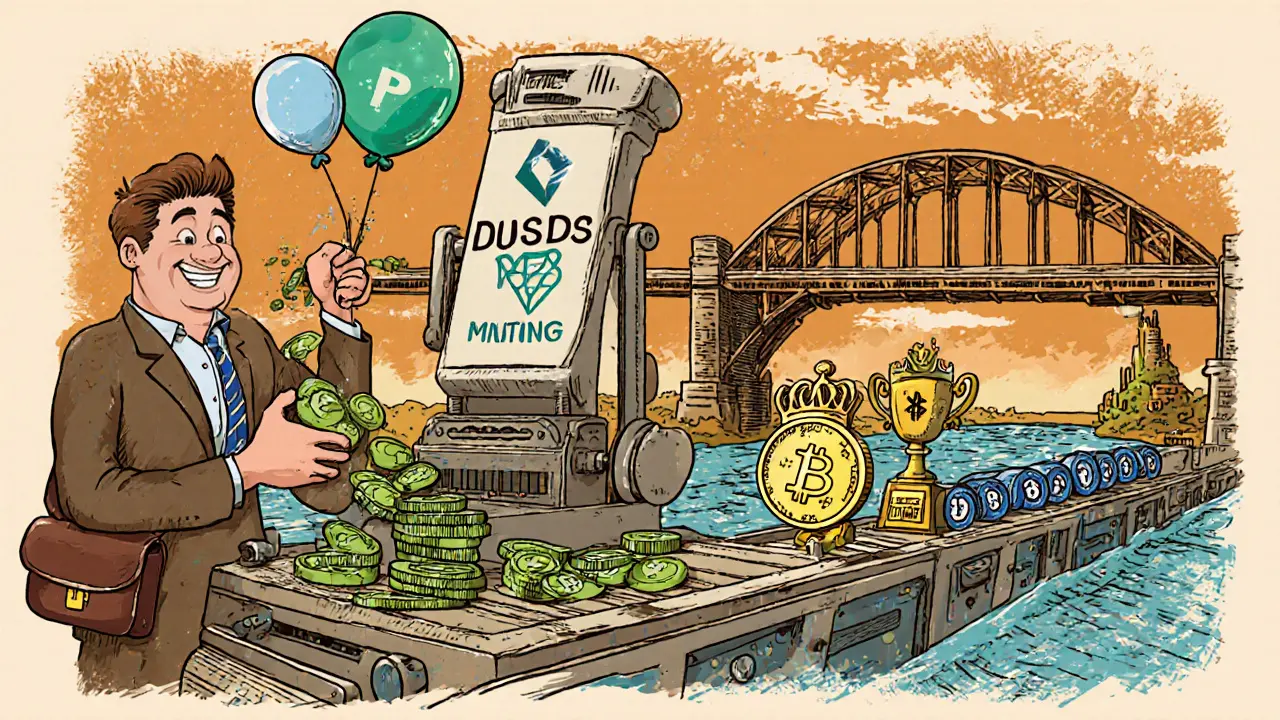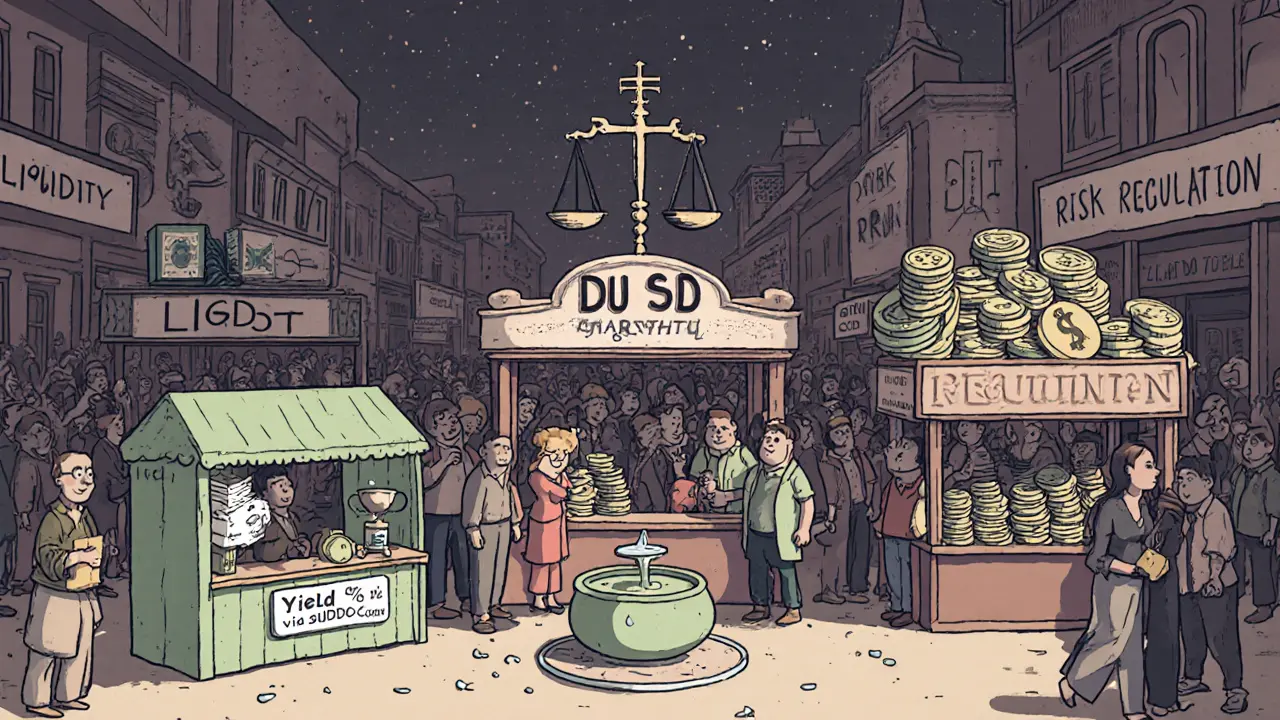
DUSD Minting Calculator
Estimated Requirements
Enter values and click "Calculate Required Collateral" to see results.
DUSD stablecoin is a decentralized stablecoin issued by Davos Protocol, designed to stay pegged to the US dollar while offering yield opportunities across multiple blockchains. Launched in February2023, DUSD serves as the backbone of the Davos ecosystem, letting users trade, lend, and borrow without the wild price swings typical of most crypto assets. It achieves stability through a hybrid model that blends crypto‑native collateral, such as liquid staking tokens, with algorithmic market mechanisms. In this guide we’ll break down what DUSD is, how it works, how you can start using it, and how it stacks up against the big‑name stablecoins.
Quick Takeaways
- DUSD maintains a near‑$1 peg using a basket of reward‑bearing crypto assets.
- Supported on Ethereum, BNB Chain, Polygon, Arbitrum, and Optimism.
- Staking DUSD yields sDUSD, which captures 5% of protocol fees.
- Cross‑chain moves are handled by TheDavosBridge with minimal fees.
- Liquidity is modest - about $173k market cap and $3.5k 24‑hour volume (July2024).
How DUSD Works - The Mechanics
The heart of DUSD’s stability is its collateral basket. When you mint DUSD, you must lock up assets such as Liquid Staking Tokens (LSTs), other stablecoins, and Liquid Restaking Tokens (LRTs). These assets keep generating rewards, which the protocol uses to cover any shortfall if the market price drifts.
Pricing data comes from DIA’s USD reference feed, providing transparent, on‑chain rates across all supported networks. The protocol does not lock users into any vesting period - you can redeem your DUSD at any moment, receiving back the underlying collateral at a 1:1 USD value, assuming the peg holds.
Beyond simple mint‑and‑redeem, DUSD introduces a dual‑token model. When you stake DUSD, you receive sDUSD. This token represents your share of the protocol’s fee pool and automatically earns a portion of the 5% fee harvested from all lending and borrowing activity on the platform.

Getting Started - Mint, Stake, and Bridge
- Connect a Web3 wallet (MetaMask, Trust Wallet, etc.) to the Davos Protocol UI.
- Select the collateral you wish to lock - for example, ETH‑staked on Lido (an LST) or USDC.
- Enter the amount of DUSD you want to mint. The platform shows the required collateral ratio in real‑time.
- Confirm the transaction. Minting typically finalizes in 2‑3minutes; gas fees vary - around $1.20 on Polygon and $3.50 on Ethereum (July2024).
- To earn yield, click the ‘Stake DUSD’ button. You’ll receive sDUSD instantly, which you can hold or use in other DeFi protocols that accept it.
- For cross‑chain moves, use TheDavosBridge. Choose source and destination chains, input the amount, and approve the transaction. Transfers usually complete in under 3minutes with fees under $0.10 on Polygon‑to‑Arbitrum.
If you ever need to exit, simply redeem your DUSD for the original collateral, or swap sDUSD back to DUSD before redemption.
How DUSD Stacks Up - Comparison Table
| Metric | DUSD | USDT | USDC | DAI |
|---|---|---|---|---|
| Market Cap | $173,088 | $111.8B | $34.1B | $5.1B |
| 24‑h Volume | $3,462 | $215M | $118M | $218M |
| Supported Chains | Ethereum, BNB, Polygon, Arbitrum, Optimism | Multi‑chain (incl. Tron, Solana) | Ethereum, Solana, Algorand, Avalanche | Ethereum, Polygon, Optimism, Arbitrum |
| Collateral Type | LSTs, LRTs, other stablecoins (crypto‑native) | Fiat reserves (centralized) | Fiat reserves (centralized) | Over‑collateralized crypto assets |
| Yield on‑chain | 5% of protocol fees (via sDUSD) | None (no native yield) | None (no native yield) | Variable (via DSR) |
| Peg Stability (latest price) | $0.996 (July2024) | $1.00±0.001 | $1.00±0.001 | $1.00±0.002 |
The table shows DUSD’s niche: a yield‑generating, multi‑chain stablecoin with modest liquidity. It can’t compete with USDT/USDC on sheer volume, but it offers something those giants lack - native fee sharing.
Pros, Cons, and Risk Factors
- Pros:
- Earn passive income simply by holding sDUSD.
- Cross‑chain transfers are cheap and fast via TheDavosBridge.
- Collateral is diversified across several reward‑bearing assets.
- Cons:
- Liquidity is thin - large trades can move the price below $1.
- Collateral ratios aren’t publicly detailed, raising transparency concerns.
- Regulatory uncertainty: crypto‑native backing may trigger security classifications under the EU’s MiCA rules.
- Key Risks:
- During market stress, LSTs and LRTs can lose value quickly, testing the peg.
- Potential for arbitrage attacks if price deviates significantly.
- Limited institutional adoption, which could hinder long‑term scaling.

Frequently Asked Questions
Frequently Asked Questions
What collateral backs DUSD?
DUSD is backed by a mix of liquid staking tokens (like Lido‑stETH), other stablecoins, and liquid restaking tokens. These assets earn rewards that help keep the peg stable.
How does sDUSD generate yield?
When you stake DUSD you receive sDUSD, which automatically claims a share of the 5% fee that the Davos Protocol collects from all lending and borrowing activity on the platform.
Can I move DUSD between blockchains?
Yes. TheDavosBridge lets you transfer DUSD across Ethereum, BNB Chain, Polygon, Arbitrum and Optimism with fees under $0.10 on most L2 networks.
Is DUSD safe during high market volatility?
The protocol’s hybrid design offers some protection, but because collateral includes crypto assets that can drop quickly, the peg may temporarily slip (as seen when DUSD fell to $0.63 in July2024). Users typically wait for arbitrageurs to restore the price or redeem during calm periods.
What are the main competitors to DUSD?
USDT, USDC, DAI, and newer yield‑focused stablecoins like FRAX, Angle USD+ and Liquity’s LUSD. DUSD’s unique angle is crypto‑native collateral combined with built‑in fee sharing.
Next Steps for Users
If you’re already comfortable with Web3 wallets, jump straight into the Davos UI and mint a small amount of DUSD (e.g., $100) to test the workflow. Keep an eye on the price: if it dips below $0.99, consider waiting for arbitrage or redeeming your DUSD for the underlying collateral.
For developers, explore the open‑source SDK on GitHub; it offers hooks for real‑time price feeds and bridge integration. Institutions should monitor regulatory updates around the EU’s MiCA framework, as those rules could affect how DUSD’s crypto‑based collateral is reported.
Overall, DUSD shines as a niche tool for DeFi users who want a stable dollar value plus passive income, but it’s still a micro‑cap project that needs bigger liquidity to become a mainstream player.





Comments (7)
Ayanda Ndoni
lol this is cute. $173k market cap? bro what are we playing at here? this ain't DeFi, it's a side project with a fancy website.
Jonathan Tanguay
Wow okay so we're back to the 'crypto-native collateral' fairy tale again? LSTs and LRTs aren't magic beans, they're just leveraged risk wrapped in a yield sticker. When ETH drops 30% like it did in May 2022, guess what happens to your 'stable' DUSD? It plummets to $0.63 like it already did. And don't even get me started on the lack of transparency around collateral ratios. You're trusting a black box that claims to be 'algorithmic' but nobody can audit the actual weights. This isn't innovation, it's just a rebranded Terra clone with a prettier UI and a bridge that costs less than a latte. And sDUSD? Yeah, 5% of protocol fees sounds sweet until you realize the protocol makes $0.02 a day in fees and you're basically earning pennies while holding a volatile asset that might not even redeem. This is the kind of thing that gets people rug-pulled when the next bear market hits and no one's left to arbitrage the peg.
John Murphy
I like how DUSD tries to do something different. Most stablecoins are just digital cash, but this one actually tries to reward you for using it. Not perfect, sure. Liquidity is tiny. Risk is real. But maybe that's the point - it's a quiet experiment, not a bank. I minted $50 of it just to see how it feels. The bridge worked. The staking was smooth. I don't expect it to replace USDC. But if I'm already in DeFi, why not hold something that pays me just for existing? Even if it's slow, even if it's small - it's trying to be more than a ledger entry.
Elliott Algarin
It's interesting how we treat stablecoins like they're supposed to be boring. But maybe the real innovation isn't in being stable - it's in being alive. DUSD isn't just holding value, it's generating something. Even if it's a trickle. Even if it's fragile. There's something poetic about a token that earns you a share of its own ecosystem. I don't know if it'll last. But I respect the attempt. Most projects want to be giants. This one just wants to be useful. And sometimes that's enough.
Akinyemi Akindele Winner
Man DUSD is like that weird cousin who shows up to Thanksgiving with a homemade pie made of kale and glitter - nobody asked for it, it’s kinda gross, but you gotta admire the audacity. You got your LSTs, your LRTs, your ‘fee-sharing’ fairy dust, and a bridge that costs less than a parking ticket. Meanwhile USDT is just sitting there like a bank vault made of pure fiat confidence. But hey, if you wanna gamble on algorithmic poetry instead of corporate spreadsheets, DUSD’s your jam. Just don’t cry when the glitter turns to ash during the next black swan.
Zach Crandall
While the technical architecture of DUSD demonstrates a commendable attempt at decentralization, one must not overlook the material regulatory vulnerabilities inherent in its collateral structure. Under MiCA, the classification of LSTs and LRTs as financial instruments may subject this protocol to full-scale licensing requirements, which it is currently unprepared to meet. Furthermore, the absence of audited, real-time collateralization disclosures constitutes a material omission under the EU’s transparency standards. While the low fees and cross-chain functionality are operationally elegant, they are rendered legally precarious by the lack of compliance infrastructure. One cannot build a stablecoin on optimism alone - legal certainty is non-negotiable in institutional finance.
Patrick De Leon
Irish people use Bitcoin, not this garbage. This is just American crypto theatre. Why are you all so obsessed with making stablecoins that earn yield? Just use EUR or USD. Keep it simple. This is why crypto is a joke.